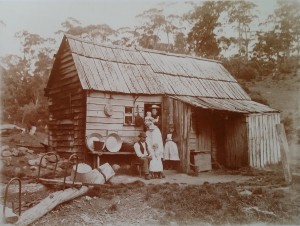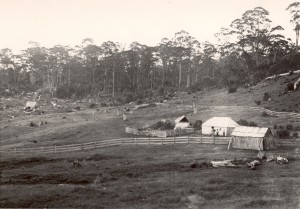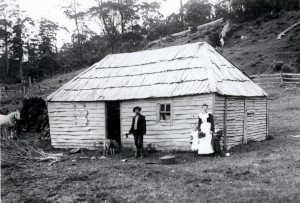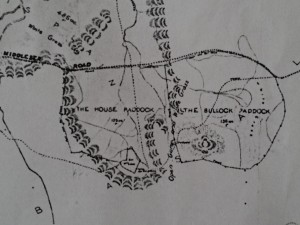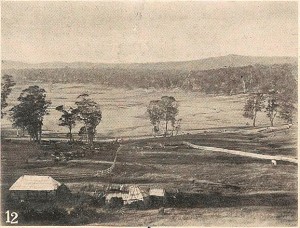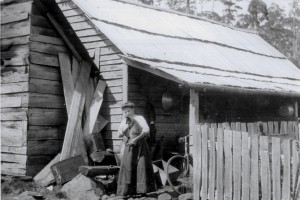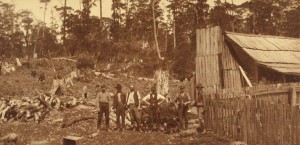When it comes to mythology, James ‘Philosopher’ Smith (1827–97), discoverer of the phenomenal tin deposits of Mount Bischoff in north-western Tasmania, has copped the lot. He was a mad hatter who ripped off the real discoverer, didn’t know tin when he saw it, threw away a fortune in shares (didn’t collect a single Mount Bischoff Co dividend) and ended up having to be saved from himself with a government pension.[1] Some of this hot air is still in circulation today—hopefully giving no one Legionnaire’s disease.
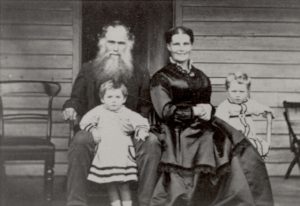

Unbeknownst to Fields’ Middlesex Plains stockman Jack Francis, he has also been mired in Smythology. My favourite version of how Jack Francis rescued—or might have rescued, given the chance—Philosopher Smith during his Mount Bischoff expedition is this published poem by E Slater:
‘How Mount Bischoff was found’
Philosopher Smith was full of go,
He tried lots of times to get through the snow,
With his swag on his back he was not very slow,
And he crawled through the bush when his tucker was low.
So he had to turn back, to Jack Francis he came,
To the stockriders’ hut on Middlesex Plains,
I was in the hut when the old man came in,
And gave him some whisky, I think it saved him.
He told us quite plain that the tin it was there,
So he never gave in, or did not despair,
He got some more tucker and went out again,
This time he found Bischoff (it was teeming with rain).[2]
Not content with having Francis save a teetotaller with a bottle of whisky, this bold author decided to mooch in on the tall tale and make himself the saviour. The poem continues, inexplicably, to describe Smith’s triumphant return from Bischoff to the Middlesex Hut after finding the tin and his exit right via Gads Hill and Chudleigh.
Why would Smith take that circuitous route home? At the time, he owned the property Westwood at Forth, but he was also renting land at Penguin while he was involved in opening up the Penguin Silver Mine.[3] At least one author has claimed that Smith’s definitive prospecting expedition was mounted from Penguin up the Pine Road he had had cut in 1868 to enable piners to exploit the forests at Pencil Pine Creek near Cradle Mountain.[4]
However, in his notes Smith made it clear that he travelled from Forth via Castra, the logical route from Westwood to the gold-bearing streams of the Black Bluff Range and the mineralised country around the Middlesex Plains. His main plan was to test the headwaters of the Arthur River for a gold matrix, in support of which he had had a stash of supplies packed out to the base of the Black Bluff Range.
And so, according to Tasmania’s late-nineteenth-century Book of Genesis, James Smith unearthed hope and prosperity in the form of tin at Mount Bischoff on 4 December 1871. What Smith’s notes tell us is that, after a week of work at Mount Bischoff, he ran out of food and—with apologies to those who have claimed he ate his dog[5]—retreated to the hut of Field’s Surrey Hills stockman-hunter Charlie Drury to beg a feed. Drury, not Francis, was the stockman Smith recalled meeting during his Mount Bischoff expedition.[6]
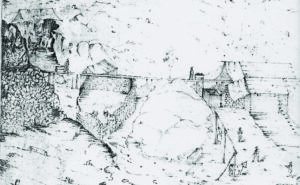
Slaughteryard Gully Face of the Mount Bischoff Tin Mine, c1876, showing the yarding and slaughter of stock reflected in its name. Courtesy of the late Charles Smith.
Regardless of Jack Francis’s non-glorification in the discovery of Bischoff, the tin mine brought a benefit to the denizens of Middlesex Station. The advent of the town of Mount Bischoff (Waratah), from about 1873, brought them closer to civilisation. However, there was no Mount Bischoff Tramway until 1877, and in its early days the town had no resident doctor. This meant that when a kick from a horse broke Jack Francis’s thigh at Middlesex in 1875, the nearest medical help was the unqualified ‘Dr’ Edward Brooke Evans (EBE) Walker of Westbank, Leven River (West Ulverstone). The round trip from the coast to Middlesex Station via the VDL Co Track—about 240 km—must have taken several days each way. ‘I had a nice jaunt to Middlesex’, Walker reported,
‘JT Field wrote asking me to go there to see a poor fellow a stock rider who had broken his thigh eight weeks before offering me £10!! to go there … I had to break it as it was 4 inches [9 cm] too short … I wrote and told him [JT Field] that he ought to supplement his offer but have had no answer … ‘[7]
Despite the pain, Jack—and/or his wife Maria Francis—made good use of this ‘down’ time, assembling a 30-shilling possum skin rug. ‘The rivers are not always fordable otherwise you would have the rugs more certain’, Jack told a customer, Van Diemen’s Land Company (VDL Co) local agent James Norton Smith.[8] He could ride, but for years the thigh injury still prevented him from walking far. In 1881 he asked the VDL Co to give him free passage to Waratah on the company’s horse-drawn tramway, enabling him to ride there after hitching his horse at the Surrey Hills stop.[9]
The establishment of Waratah also raised the Francis family’s social profile. One-time recipients of Her Majesty’s pleasure (they were both ex-convicts) became vice-regal hosts. In January 1878 Jack, Maria and possibly young George Francis put up Lieutenant Governor Frederick Weld at Middlesex Station. Escorted by a young Deloraine Superintendent of Police, Dan Griffin, and guided by Thomas Field, the vice-regal party negotiated Gads Hill on its way to visit the new mining capital—Weld being the first governor since George Arthur to tackle the VDL Co Track.[10] So it was that Jack Francis scored his moment of glory without even tempting the temperate Philosopher.
[1] For Smith finding the Mount Bischoff tin in the hut of stockman Charles Drury (‘Dicey’), see ‘The story of Bischoff’, Advocate, 24 April 1923, p.4. For Smith failing to identify the tin when he saw it, see, for example, Ferd Kayser, ‘Mount Bischoff’, Proceedings of the Australasian Association for the Advancement of Science (ed. A Morton), vol.iv, Hobart, 1892, p.342. For Smith squandering a fortune and having to be saved by the Tasmanian Parliament see, for example, ‘Parliamentary notes’, Launceston Examiner, 21 October 1878, p.2. For Smith ‘not making a cent’ out of Mount Bischoff tin and not collecting a single dividend from the Mount Bischoff Tin Mining Co, see, for example, Carol Bacon, ‘Mount Bischoff’; in (ed. Alison Alexander), The companion to Tasmanian history, Centre for Tasmanian Historical Studies, University of Tasmania, Hobart, 2005, p.243.
[2] E Slater, ‘How Mount Bischoff was found’, Waratah Whispers, no.15, March 1982; reprinted there from ‘an old newspaper cutting’.
[3] Application to register the Penguin Silver Mines Company was gazetted on 23 August 1870. The assessment roll for the district of Port Sorell for 1870 lists Smith as the occupant of a hut on 47 acres at Penguin owned by Thomas Giblin of Hobart (Hobart Town Gazette, 22 February 1870, p.298).
[4] See ‘Penguin old and new: record of great development’, Weekly Courier, 17 December 1927, p.35.
[5] See, for example, ‘Nomad’, ’Correspondence: Philosopher Smith’, Circular Head Chronicle, 25 May 1927, p.3.
[6] James Smith notes, ‘Exploring’, NS234/1/14/3 (TAHO).
[7] EBE Walker to James Smith, 8 July 1875, NS234/3/1/4 (TAHO).
[8] Jack Francis to James Norton Smith, 13 October 1875, VDL22/1/5 (TAHO).
[9] Jack Francis to James Norton Smith, 11 April 1881, VDL22/1/9 (TAHO).
[10] ‘Vice-regal’, Tribune, 28 January 1878, p.2; ‘DDG’ (Dan Griffin), ‘Vice-royalty at Mole Creek’, Examiner, 15 March 1918, p.6.
